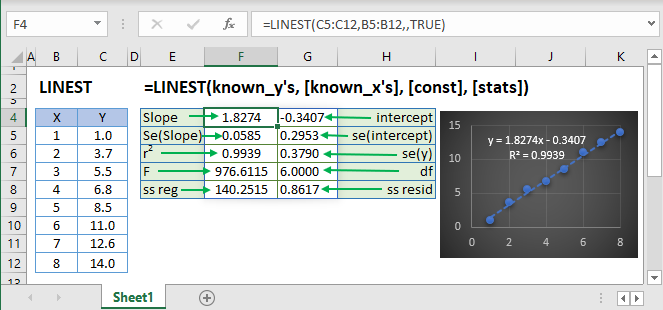

Once you've seen how to replicate the LINEST() results using straightforward matrix algebra, you'll be in a position to see how Microsoft got it badly wrong when it offered LINEST()’s third option, const. A little matrix algebra is needed and it will be necessary for you to be familiar with the concepts behind the worksheet functions MMULT(), MINVERSE(), and TRANSPOSE(). This paper continues with a discussion of how the results provided by LINEST() can be calculated, and how you can replicate those results using Excel's native worksheet functions. The issues that I'm going to discuss in subsequent papers are more serious, particularly if you're still using a version of Excel prior to 2003. Nevertheless, this is principally a matter of convenience.
Excel linear regression parameters full#
I recognize that one could use the TREND() function instead of assembling the regression formula, coefficient by coefficient and variable by variable, but there are often times when you need to see the result of modifying one variable or coefficient the only way to do that is to call them out separately in the full equation. With 20 of each, it's tedious and error-prone.Īnd there is absolutely no good reason for it-statistical, theoretical or programmatic. To complete the regression equation, you need to proceed left-to-right for the variables and right-to-left for the coefficients.

But with 5, 10, perhaps 20 variables, it becomes exasperating. With just two variables, this is a really minor issue. Instead of the more natural and more easily interpreted: So if you wanted to use the regression equation to estimate the income of the first person in Row 2, you would need to use this formula (parentheses included for clarity only): (The intercept, in cell G5 in Figure 1, always appears rightmost in the LINEST() results.) But in the underlying data set, the Education data (column A) precedes the Age data (column B). The problem is that the regression coefficient for Age is in cell E5, and the coefficient for Education is in cell F5: in left-to-right order, the coefficient for Age comes before the coefficient for Education. Only by setting the third argument to FALSE can you force LINEST() to remove the constant from the regression equation. You can also omit the argument and Excel regards that as setting it to TRUE: LINEST()'s third argument, called const, is set to TRUE in the example just given.


 0 kommentar(er)
0 kommentar(er)
